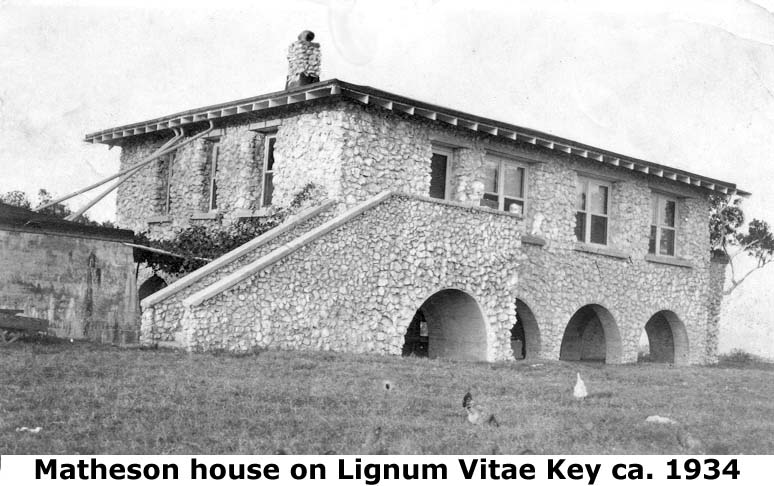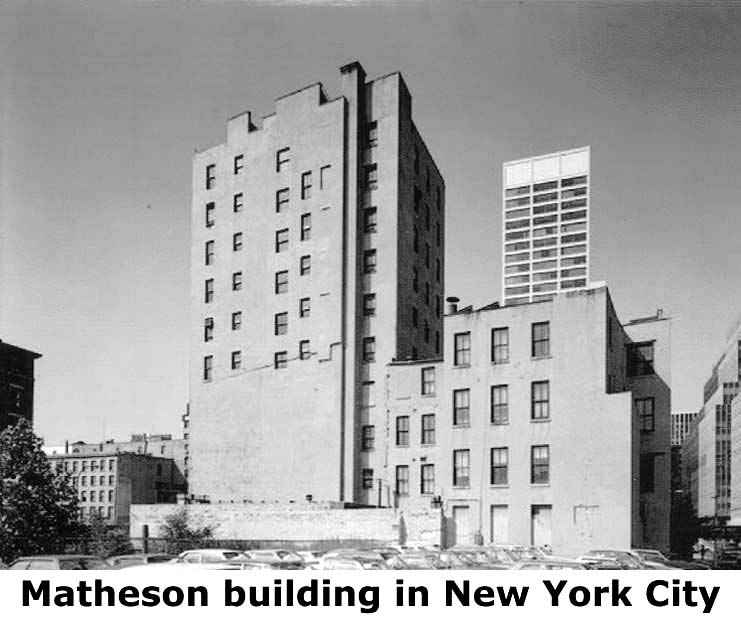Life and Times of
William John Matheson
- Page 4 -
These pages by Jerry Wilkinson- World War One -
The onset of World War I in 1914 affected and effected the chemical industry, especially the pigments portion. Until then Germany dominated the high-end of the industry, and with Germany engaged in a war, it used all its machinery and output to support its war effort. The U. S. was cutoff from all Germany’s exports. As the conflict worsened the more effect it had on the United States. William J. also had plants in Germany that were cut off from imports of the free world.
From page 330 of The Notes of Clarence Barron, William J. said: “I retired from business before the war. For forty years I worked and studied nights to keep abreast of the times in chemistry. I could manufacture in Germany cheaper than here, but when the war broke out my imports were were cut off. . . . The government appealed to me to come back into the chemical line, as I was the only man in the country that knew all that could be known at that time about aniline dyes and the chemistry connected therewith.”
Matheson’s Cassella Color Company, which was primarily in dyes, took a lead in stabilizing the industry. Heretofore hindered by the German patents, the American government seized the patents and put them under the control of a licensing corporation – all is fair in love and war.
In an effort to beat the competition before the war William J. had made himself an expert in patent law. Seeing the end of the German dominance, his talents were drawn upon one way or another by most of the larger chemical groups. Successes and opportunities abounded at every corner, and William J. was there. He had the intuitive perception to grasp the situation and move expertly. Reportedly, at the outbreak of the war he severed his German connections and founded the National Aniline and Chemical Company. This company was later consolidated with other companies to become Allied Chemical and Dye Company.
One of many of his accomplishments was his seat on the Directorate of the General Chemical Company which was the key for America to quickly enter into the manufacture of the pigments to support its involvement in the war. The General Chemical Company was a complicated enterprise of other chemical companies that made most of the base products – the same companies that Germany had successfully prevented from competing with its products. His chemical background, patent law knowledge, industrial leadership and outstanding business acumen made him a winner everywhere he turned.
Again from The Notes of the Late Clarence W. Barron on page 330 William J. states “. . . When the war ended I was producing forty to fifty tons of mustard gas a day beside tear gas and other gases.”
St. Andrews University programmed an honorary LL.D. degree for William J. scheduled for July 2, 1920. He found it impossible to travel to Scotland so the Senatus Academicus conferred it “in absentia.”
Going back one year to May 16, 1919, William J. purchased Lignum Vitae Key in the Florida Keys from the former coconut planters, the Hine Brothers. Hine Brothers was a New Jersey Corporation of Thomas A. Hine and Charles C. Hine (deceased). There is considerable support that he purchased Lignum Vitae Key for some sort of an experimental project with David Fairchild. A stone caretaker’s house, lime grove and coconut palm grove were soon in place. Dr. William J. transferred Lignum Vitae Key to Hugh on January 30, 1929. The Executors of the Estate of Hugh M. Matheson sold the island to George Deen on March 11, 1953 for $125,000.00.
- The coconut palm plantation - Back to Key Biscayne, the reason for changing from avocado, mango and lime trees to coconut palms is not clear. He appeared to abandon limes almost completely, but Hugh would carry the flag for the lime industry for another two decades or so. Hugh later formed the “Florida Key Lime Growers Association”, however the Persian lime won the race. It was larger, packed better, greener in color, and shipped better, but to the purist it could not match the taste.
Key Biscayne was originally owned (for 75 cents an acre) and planted in coconuts (1880s) by Ezra Osborne and Elnathan Field. James A. Waddell planted huge areas of coconuts at Cape Sable (30 rows, four miles long) as well as Thomas and Charles Hine in the Florida Keys.
Keeping his tradition of doing things on the large scale, by 1920 there were about thirty-six thousand coconut palms, Cocos nucifera, growing on Key Biscayne. The coconut is one of the world’s 12 greatest food producers, rice being number one. The coconut palm is not native to the Americas and not to Europe either. Like the key lime, it is native to Asia. They were brought to Africa and Europe by the early seafaring spice traders, then by the Spanish to the New World. The key lime was to prevent scurvy and some say that the coconut was the world’s greatest canteen. First it required no refrigeration, did not bruise or break easily, was good ballast, then one drink the liquid, eat the meat, make utensils of the shell and use the fibers for whatever. There was no waste.
The general belief is that Ferdinand Magellan in his voyage around the world transported the coconut to the Philippines in 1521. This could be disputed as his crew was near starvation before arrival, therefore few coconuts would have arrived. However, it would only take one!
David Fairchild, William J. and Hugh found one of the problems to raising coconuts commercially. In his paper The Makapuno Coconut of the Philippines, 1949, Fairchild expounds on the fertilization of the coconut palm and summarizes that “. . . cross pollination is the rule rather than the exception. . .” In 1920 he found 86 known varieties in Florida. At that time they did not know of the lethal yellowing that would appear in the 1970s.
Fairchild wrote in 1921, “The first important introduction of a coconut variety was when W. J. Matheson financed the bringing in of the Malay Dwarf coconut palm from the Federated Malay States and established them on his Key Biscayne plantation.” As aforementioned, it came true in the 1970s when scientists announced that the Malay Dwarf palm was one of the few coconut palms (others are the Panama Tall and Maypan palms) that can fight the disease. The name of William J.‘s luxurious houseboat to transport guests from the Swastika House to the Mashta House was the Coconut.
Up to the 1920s it appeared that William J. was a total preservationist. The only construction that he did was for his own benefit or to further the growth of flora. Hugh shared this with his father except he added his love for endangered animals. And to an extent, so was Anna who held onto the Fort Hill estate to death while donating pristine meadows and beaches for public use. Anna’a approach was neighbors are friends and friends are neighborly.- The Florida Land Boom - William J. owned the northern two thirds of Key Biscayne. He wanted to purchase the southern one third also but while he was away in 1915, James Deering beat him to it. At first Deering had no plans to develop the property, but that changed as time passed with a plan to build an exclusive housing development. There were various delays, a decision to restore the Cape Florida Lighthouse and a deed lawsuit that went all the way to the Supreme Court. James Deering died in 1925 before much was done with the property.
The 1920s were a bizarre period for Florida. This period is known as the Florida Land Boom. People bought and sold everything, often two or three times a day; so why could not James Deering? And, why could not Dr. Matheson? Land development was to Florida as gold was to the west.
To the uninformed, Deering’s death would seem to be his opportunity to own the entire island; however, William J. had been contacted by Tampa’s land baron, Mr. D. P. Davis – builder of exclusive pumped and filled Davis Island. So instead of buying south Key Biscayne, William J. contracted to sell much of his submerged northern portion to Mr. Davis. Mr. Davis was an expert at dredge and fill operations and loved inexpensive riparian property rights. The contract was delayed and during the delay, mother nature visited Miami in the form of the Great 1926 Hurricane.
